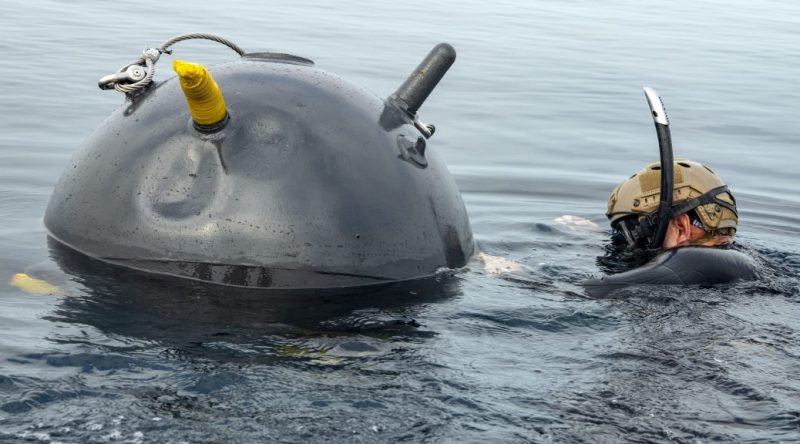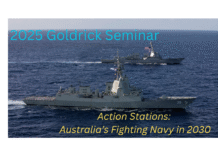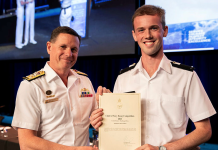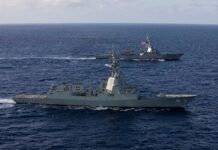
By Dr. Keith Aliberti and Mike Kobold, Naval Surface Warfare Center, Panama City Division
Sea mines have long been used as an effective form of asymmetric warfare as they are “easy to lay and difficult to sweep; their concealment potential is strong; their destructive power is high; and the threat value is long-lasting.”1 Key objectives of utilizing sea mines for “blockading enemy bases, harbors, and sea lanes; destroying enemy sea transport capabilities; attacking or restricting warship mobility; and crippling and exhausting enemy combat strength”2 clearly demonstrate that sea mines pose a significant threat to the U.S. Navy and its allied navies.
The U.S. Navy has developed a vast array of novel technologies to counter the ever evolving mine threat and has made great advancements in its MCM capabilities. We contend, however, that in order to make revolutionary advancements in our ability to counter mines, a shift from direct, operational/tactical-level thinking to indirect, strategic-level thinking needs to occur.
Borrowing from great advancements that the U.S. has made in its ability to counter improvised explosive devices (C-IED) over the past 17 years of war, we contend that an overarching strategic approach is necessary – a pervasive, persistent intelligence, surveillance, reconnaissance (ISR) approach to MCM that requires a paradigm shift in how we approach the problem. Over the course of the wars in Afghanistan and Iraq, the U.S. military shifted from the operational/tactical strategy of “finding, fixing, and finishing IEDs” to a strategic approach of pervasively and persistently surveiling vast spaces to “know” where IEDs are. This approach required a paradigm shift in how to counter IEDs that was met with great success. We argue that MCM requires a shift in mindset from looking at MCM as an operational/tactical problem of “finding mines” to a strategic problem of “knowing where a mine is, a priori.”
It is no small feat to monitor a region, day and night, 24/7, to provide overarching ISR that can be utilized to say, with utmost confidence, that there is something of interest at a particular location. For land-based ISR, the U.S. military has at its disposal significant overhead imaging capabilities (whether from blimps, manned/unmanned aircraft, and/or satellites) to enable the realization of this approach. The challenges we face in countering mines, however, are compounded by, what these authors refer to as, the 3 by 3 problem: Mines are typically deployed via air, surface, and undersea platforms; are often found on the seafloor (proud or buried), moored, or drifting; and are typically of the contact, influence, or remotely detonated type. In essence, we have to deal with myriad mine threat types and operational environments.
Strategically, operationally, and tactically, our ability to yield an overarchingly pervasive and persistent MCM ISR capability cannot be achieved without significant advancements in our technical capabilities. Rapid establishment of long sea lines of communication, offshore operating areas, amphibious operating areas, and littoral penetration areas are required to establish large, safe operating areas and transit routes – and all of these drive MCM mission requirements. Time is paramount for MCM operations and while our desire for an “all-knowing” capability is not yet within reach, intersection of the core ISR components of multimodal and multidimensional continuous collection across the littoral battlespace (sensing), near-real-time and knowledge distribution (delivery), and horizontal integration of data coupled with advanced, distributed analytics (sensemaking and understanding), will enable “perfect knowledge.”3
One example of a niche capability developed over the past few years that will contribute to pervasive, persistent ISR is the U.S. Navy’s commitment to address near real-time knowledge distribution. Critical to our ability to sense and deliver within MCM operations and to “know” where mines are, will be large, distributed underwater wireless sensor networks (DUWSNs) that utilize novel acoustic underwater communication protocols. DUWSNs, as envisioned, are self-organizing networks of mobile sensors that enhance sensing, monitoring, and surveillance capabilities. They form a mobile, dynamic observation system to enhance the ability to detect, classify, localize, and track events of interest to provide underwater sensing and surveillance capabilities that will lead to more precise knowledge about surface, subsurface, and underwater activities, particularly for the detection, classification, and location of mines and minefields. DUWSNs are both mobile and dynamic (can adapt to changing conditions) in nature. In addition, they can monitor and detect time-varying events occurring within both their local and extended underwater environments. DUWSNs, when fully realized, will provide “perfect knowledge” about surface and subsurface activities and, hence, to the “all-knowing” capability that is necessary to provide revolutionary capabilities for MCM.
Inherent to the success of DUWSNs is effective communication, using acoustics, amongst all of the dynamic nodes of the network. Underwater acoustic channels, however, feature large-latency and low-bandwidth. In addition, the sensor nodes of a DUWSN are mobile and will shift position relative to one another due to dispersion and shear thereby resulting in coordinated networking amongst large numbers (potentially hundreds to thousands) of densely-deployed sensors a challenge. The “rules” by which the sensor nodes communicate, otherwise known as communication protocols, are key to advancing near-real-time delivery of information. The U.S. Navy has conducted research and development on novel network architectures to meet the needs of short-term, time-critical and long-term, non-time-critical MCM operational requirements. Using a systems engineering approach to acoustic communications, we have developed statistical models of undersea acoustic transmissions that allow a priori decisions on what communication protocols are to be used to communicate effectively and efficiently based on the location of the DUWSNs. Specifically, there are anisotropies and inhomogeneities in the water column that cause deviations in acoustic direct-path trajectories. We have used sound speed profiles (SSPs) that simulate tidal and storm variations (deterministic) and various random SSPs, both based on measurements, and this has led to our ability to develop specific, effective, and efficient communication protocols. We have developed Acoustic Modem Protocol Statistics (AMPS) that enable the calculation of throughput in terms of the percent of communication packets properly received using modem specifications. This research greatly enhances our ability to develop the right acoustic communication protocols to meet the demands of advanced underwater networks.
We want to stress that acoustic communication protocols and advances in DUWSNs are one component of the aforementioned overarching strategic shift in our thinking of how to address the challenges posed by sea mines. What DUWSNs provide is not so much in their technical capability, but a shift in how to apply new, innovative technologies to look at the MCM problem. In essence, the intent is for DUWSNs to be part of a much larger system-of-systems that includes unmanned underwater vehicles, components of subsea and undersea warfare, and littoral operations to enable pervasive and persistent ISR capabilities that will provide a major strategic, operational, and tactical advantage for MCM operations.
Dr. Keith Aliberti received his doctorate and master’s degrees in Physics from the University Center at Albany, State University of New York, in 1998 and his bachelor’s degree in Physics from Rensselaer Polytechnic Institute in 1992. He is the head of the Science and Technology Department at the Naval Surface Warfare Center, Panama City Division, where he oversees research and development of mine countermeasures technologies, advanced mining, unmanned system technologies, and maritime special programs.
Mr. Michael Kobold received his master’s degree in Physics from the University of Michigan and his master’s degree in Electrical Engineering from the Air Force Institute of Technology. He is an optics, seismic, acoustic, and image processing scientist in the Intelligent Sensing and Irregular Warfare Branch of the Naval Surface Warfare Center, Panama City Division, and holds a Professional Engineering License in Mechanical Engineering. He has extensive experience in nonlinear structural engineering, remote sensing, infrasound-related security and stability operations surveillance techniques, and electro-optics. Recently, his efforts have been focused on acoustical communications in underwater networks.
References
[1] Erickson, Andrew S., Goldstein, Lyle J., and Murray, William S. “Chinese Mine Warfare: A PLA Navy ‘Assassin’s Mace’ Capability”, Naval War College China Maritime Studies #3, June 2009. [2] Ibid. [3] Stojanovic, Milica and Beaujean, Pierre-Philippe J. “Acoustic Communication.” In Springer Handbook of Ocean Engineering, pp. 359-386. Springer, Cham, 2016. [4] Hogan, Todd C., “The Persistent Intelligence, Surveillance, and Reconnaissance Dilemma: Can the Department of Defense Achieve Information Superiority?”, Thesis presented to the Faculty of the U.S. Army Command and General Staff College, Fort Leavenworth, Kansas, 2007. Republished with permission of the Center for International Maritime Security.


